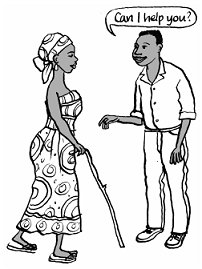The Blind: How to Lend Them a Helping Hand on the Road
What must be realized is that when a sighted person offers help to someone with visual impairment, it can cause confusion and difficulty for both. The simple rule is if someone seems to need help, offer it - but make a point of asking first. It is wrong for us to assume that because people are blind or partially sighted, they need help. When you approach the blind, bear in mind that they probably will not be aware of your approach. Donít, for instance, grab their hand before you speak. They may mistake you for a mugger. Greet them and ask if they need help. At this point you can touch their arm lightly to indicate that you are talking to them. If they need assistance, ask where they want to go. Donít just assume that because they are standing at a robot, they want to cross the street. Offer your arm to the blind person to grip just above the elbow. Keep your guiding arm straight with your fingers pointing towards the ground. This ensures that the person you're guiding will be a half step behind you and will be able to detect any body movements that indicate a turn or a step. This is why it is best for them to take your arm rather than your taking theirs. Before you move off, make sure you are both facing in the same direction. Walk at an even pace - not too slow and definitely not too fast.
If the steps or stairs have a handrail or banister, tell the person you are helping. Some blind people prefer to use their foot to feel where the step begins, before going down steps or stairs. If you happen to be in a crowd or confined space, you may need to walk in a single file. To do this move your arm round to the centre of your back, still keeping it straight. The person you are guiding will move in behind you, extending his own arm to allow enough distance to walk comfortably. When the need to walk in single file is over, move your arm back to its original position to resume walking side by side. When the trip is over make sure the blind person knows where he is, the direction he is facing and where to go next. When you leave, say that you are going so the person is not left talking to himself. Some points to note
Related Topics
|
 THE visually handicapped, like the sighted, need to shop and use public
transport and our roads. Crowded streets, poor paving, and badly parked cars can
often turn our streets into obstacle courses for the visually impaired. But as
much as many of us want to help, we should be careful about how we do it.
THE visually handicapped, like the sighted, need to shop and use public
transport and our roads. Crowded streets, poor paving, and badly parked cars can
often turn our streets into obstacle courses for the visually impaired. But as
much as many of us want to help, we should be careful about how we do it. You will take the step or stair before the blind person since you will be
walking a half pace ahead. The change in your arm position will indicate the
approach to a step. As you approach it, pause and say "step up", or
"step down". When you reach level ground take a pace, then pause, to
give the blind person time to complete the last step.
You will take the step or stair before the blind person since you will be
walking a half pace ahead. The change in your arm position will indicate the
approach to a step. As you approach it, pause and say "step up", or
"step down". When you reach level ground take a pace, then pause, to
give the blind person time to complete the last step.